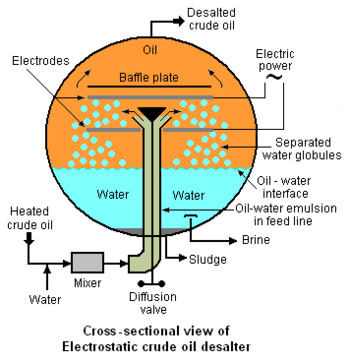User:Milton Beychok/Sandbox
A crude oil desalter is a device used in petroleum refineries to remove inorganic salts, water and sediment from the incoming petroleum crude oil feedstock before it is refined. This article focuses on the use of electrostatic desalters to produce a dehydrated, desalted crude oil with a very low sediment content.[1][2][3][4] Almost all refineries now use electrostatic desalters. However, there may still be a few refineries employing the older, less efficient method that utilizes chemicals and settling tanks.
Removal of the salts, water and sediment is necessary to avoid excessive fouling of equipment as well as corrosion from the generation of hydrochloric acid (HCl) by the hydrolysis of the chloride salts present in the incoming crude oil, in particular magnesium chloride (MgCl2) and calcium chloride (CaCl2). Any salts that are not removed represent a source of metals that can "poison"[5] expensive catalysts used in various petroleum refinery processes.[1][2][3].
The salt, water and sediment in crude oil as received by refineries
The amount of water, salts and sediment in the crude oil as received at petroleum refineries varies widely with the source of the crude oil, the prior processing of the crude oil at the source sites and with the mode of transporting the crude oil from its source to the refineries.
References
- ↑ 1.0 1.1 Jean-Pierre Wauquier (Editor) (2000). Petroleum Refining, Volume 2, Separation Processes. Editions Technip. ISBN 2-7108-0761-0. Limited preview in Google Books
- ↑ 2.0 2.1 Francis S. Manning and Richard E. Thompson (1995). Oilfield Processing, Volume 2: Crude oil. Pennwell Books. ISBN 0-87814-354-8. Limited preview in Google Books
- ↑ 3.0 3.1 Beychok, Milton R. (1967). Aqueous Wastes from Petroleum and Petrochemical Plants. John Wiley & Sons. Library of Congress Control Number 67019834.
- ↑ Petroleum Wastewater – A Case Study Greg Johnson (from Water and Wastewater.com)
- ↑ Irreversible deactivation of catalysts.
- ↑ Note: In the United States (and perhaps elsewhere), the amount of inorganic salts in crude oil is expressed as pounds per thousand barrels and abbreviated as PTB. Based on a crude oil having an API gravity of 34 °API (which is equivalent to having a specific gravity of 0.8550), 1 PTB of salt = 3.4 ppm by weight of salt.

